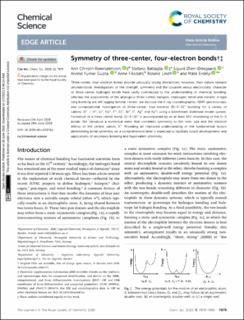Symmetry of three-center, four-electron bonds
| dc.contributor.author | Holta, Ann Christin Reiersølmoen | |
| dc.contributor.author | Battaglia, Stefano | |
| dc.contributor.author | Øien-Ødegaard, Sigurd | |
| dc.contributor.author | Gupta, Arvind Kumar | |
| dc.contributor.author | Fiksdahl, Anne | |
| dc.contributor.author | Lindh, Roland | |
| dc.contributor.author | Erdélyi, Máté | |
| dc.date.accessioned | 2021-02-15T13:36:14Z | |
| dc.date.available | 2021-02-15T13:36:14Z | |
| dc.date.created | 2020-11-05T12:11:41Z | |
| dc.date.issued | 2020 | |
| dc.identifier.citation | Chemical Science. 2020, 11 (30), 7979-7990. | en_US |
| dc.identifier.issn | 2041-6520 | |
| dc.identifier.uri | https://hdl.handle.net/11250/2728138 | |
| dc.description.abstract | Three-center, four-electron bonds provide unusually strong interactions; however, their nature remains ununderstood. Investigations of the strength, symmetry and the covalent versus electrostatic character of three-center hydrogen bonds have vastly contributed to the understanding of chemical bonding, whereas the assessments of the analogous three-center halogen, chalcogen, tetrel and metallic [small sigma, Greek, circumflex]-type long bonding are still lagging behind. Herein, we disclose the X-ray crystallographic, NMR spectroscopic and computational investigation of three-center, four-electron [D–X–D]+ bonding for a variety of cations (X+ = H+, Li+, Na+, F+, Cl+, Br+, I+, Ag+ and Au+) using a benchmark bidentate model system. Formation of a three-center bond, [D–X–D]+ is accompanied by an at least 30% shortening of the D–X bonds. We introduce a numerical index that correlates symmetry to the ionic size and the electron affinity of the central cation, X+. Providing an improved understanding of the fundamental factors determining bond symmetry on a comprehensive level is expected to facilitate future developments and applications of secondary bonding and hypervalent chemistry. | en_US |
| dc.language.iso | eng | en_US |
| dc.publisher | Royal Society of Chemistry | en_US |
| dc.rights | Navngivelse 4.0 Internasjonal | * |
| dc.rights.uri | http://creativecommons.org/licenses/by/4.0/deed.no | * |
| dc.title | Symmetry of three-center, four-electron bonds | en_US |
| dc.type | Peer reviewed | en_US |
| dc.type | Journal article | en_US |
| dc.description.version | publishedVersion | en_US |
| dc.source.pagenumber | 7979-7990 | en_US |
| dc.source.volume | 11 | en_US |
| dc.source.journal | Chemical Science | en_US |
| dc.source.issue | 30 | en_US |
| dc.identifier.doi | 10.1039/d0sc02076a | |
| dc.identifier.cristin | 1845231 | |
| dc.description.localcode | Open Access Article. Published on 30 June 2020. This article is licensed under a Creative Commons Attribution 3.0 Unported Licence. | en_US |
| cristin.ispublished | true | |
| cristin.fulltext | original | |
| cristin.qualitycode | 1 |
Tilhørende fil(er)
Denne innførselen finnes i følgende samling(er)
-
Institutt for kjemi [1355]
-
Publikasjoner fra CRIStin - NTNU [37236]

